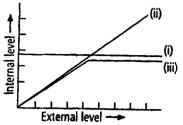In a population growth rate curve the lag phase represents the period when a population is adjusting to a new environment.
II. In a population growth rate curve the steepest part of growth phase represents the period when a population is growing exponentially.
III. In the stationary phase of a population growth rate curve the population is in dynamic equilibrium
IV. Human have changed the carrying capacity of the earth.
(1) All are correct
(2) I, II, III
(3) II, III
(4) I, IV
II. In a population growth rate curve the steepest part of growth phase represents the period when a population is growing exponentially.
III. In the stationary phase of a population growth rate curve the population is in dynamic equilibrium
IV. Human have changed the carrying capacity of the earth.
(1) All are correct
A broad-based, pyramid shaped age structure is characteristic of a population that is:
1. Growing rapidly
2. At carrying capacity
3. Stable
4. Shrinking
Carrying capacity for a population is estimated at 500; the population size is currently 400; and rmax = 0.01. What is dN/dt?
(1) 0.01
(2) 0.8
(3) 8
(4) 50
The evolution of the animal immune system was probably driven by:
(1) Herbivores pushing the animals toward extinction
(2) The selective pressures of parasitic and disease organisms
(3) Competition between the animals and their habitats
(4) Symbiosis between the animals and their predators
Which of the following is not entirely true fact?
1. Competition occurs when closely related species compete for the same resources that are limiting
2. Totally unrelated species could compete for the same resource
3. Resources need not be limiting for competition to occur. In interference competition, the feeding efficiency of one species might be reduced due to the interference and inhibitory presence of the other species, even if resources are abundant.
4. A complex interplay of interspecific interactions and environmental variability characterizes community structure
Connell's elegant field experiments are related to:
1. Paramecium
2. Barnacles
3. Viruses
4. Protozoans
Select the false one:
1. The niche of a population is the set of conditions and resources it uses
2. Competitive exclusion principle was first described by Gause, for species of Paramecium
3. If a new predator is introduced to an area the prey species is likely to decrease and possibly become extinct
4. None of the above
A bird introduced from another country became a serious pest due to:
1. Better adaptation to new area
2. More sexual reproduction
3. Better nesting habitats
4. Absence of natural competition
Through resource partitioning:
1. Two species can compete for the same prey
2. Slight variation in niche allow closely related species to co-exist in the same habitat
3. Competitive exclusion results in the success of the superior species
4. Two species undergo character displacement that allows them to compete
The figure given below is a diagrammatic representation of response of organisms to abiotic factors. What do (i), (ii) and (iii) represent respectively?
| (i) | (ii) | (iii) | |
| (1) | Conformer | Regulator | Partial regulator |
| (2) | Regulator | Partial | Conformer regulator |
| (3) | Partial | Regulator | Conformer regulator |
| (4) | Regulator | Conformer | Partial regulator |

